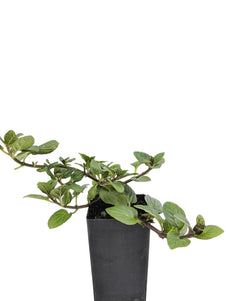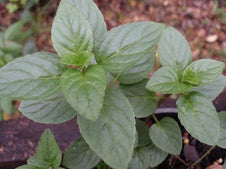



Mint - Chocolate Mint
Mint - Chocolate Mint

- In stock, ready to ship
- Inventory on the way

Usually available: All year
Life cycle: Perennial
Height: 45 - 60cm
Position: Sun / part shade
Soil preference: Moist / well drained
This is how we pack and send your Herb Plants to all states except TAS & WA
You will receive
- 1 Chocolate Mint Herb Plant in a 50 X 75mm tube - General growing instructions
All of our Herb Plants are grown organically with certified organic potting mixes and fertilizers
This is how we pack and send your Herb Plants to all states except TAS & WA
You will receive
- 1 Comfrey Herb Plant in a 50 X 75mm tube - General growing instructions
All of our Herb Plants are grown organically with certified organic potting mixes and fertilizers
Botanical Name: Mentha X piperita f. citrata ‘Chocolate’
Chocolate Mint is a medium growing mint reaching up to 60cm tall, with a spreading nature up to 60cm. The large ovate leaves are a bronze – dark green, with deep reddish-purple stems. The lilac-purple flowers appear in summer and open from the bottom of the false whorl, progressing to the top of the inflorescence.
The aroma and flavour are open to interpretation. Some people describe the taste as like peppermint with chocolate undertones, while others cannot detect the chocolate flavour at all. The parent plant is Peppermint, so this is the main flavour with the chocolate being a novelty. Nibbling the leaves is a sure way to find out whether your palate can detect the subtle difference.
The botanical name is Mentha x piperita for the Peppermint parent which is itself Mentha aquatica (Watermint) x Mentha spicata (Spearmint). In some references the full name given is Mentha x piperita f. citrata, because there are several flavoured mints developed from the same breeding. These include Basil Mint and Orange Mint.
Mint General
There are many Mint varieties known to herb gardeners and lovers of good cuisine, all varying slightly in flavour, aroma and appearance. They are categorized in the genus ‘Mentha’, which has up to 18 species, within the Lamiaceae family of plants. The Lamiaceae family is known as the mint family. However, the largest group of plants in the mint family is actually the delightful Salvias with their brilliantly coloured blooms. Many other commonly known herbs are also found in this family, including basil, sage, thyme and even lavender. One characteristic of this plant family is that they all yield essential oils, giving each plant its unique characteristics and even potential for medicinal use. Even the Scutellaria genus, with the unusually named Baikal Skullcap is found within this family.
The mints consist of mostly spreading and low growing perennial plants. The height range is from 10 cm to 1 meter, so not all are at ground level. Mint plants send out runners, or stolons, to help them spread by developing roots and shoots at the nodes. This allows plants to cover up to 1 meter in stem growth, in good conditions. They are all fast growing plants and due to the spreading nature, one plant is often sufficient for most gardeners. Some mints can be invasive and it is recommended that containers or in ground barriers be used. Mints can suffer from some pests like snails and aphids and may be affected by mint rust.Rust Free Mint may also be a useful addition to the garden in addition to the many other varieties.
Most mint plants have square stems, with leaves held in opposite pairs. They are often downy with a serrated margin, with a variable leaf shape and colours ranging from green to purple. The flowers are usually white to purple and present in false whorls or verticillaster or false whorl. The corolla is usually two lipped and has 4 lobes, with the upper lobe usually the largest.
Mint plants come from across the globe and will grow in most climates, including a wide range of regions across Australia. Some are annual varieties, but in cool climate zones perennial mints may best be treated as annuals and replaced each year. Generally they have high water requirements and prefer rich soils. Mint is grown commercially in Tasmania due to the ideal conditions of long summer days in high altitudes, where temperatures average 25C during the day to 15C at night. Ideal conditions usually require full sun, but part shade may be necessary as temperatures increase in warm summer regions.
Most mints have a history of traditional medicinal or herbal use for fevers, headaches and minor ailments. These plants are often used as a digestive aid in the form or herbal tea. The essential oil is also antiseptic and may be toxic in very high doses. They should be avoided by pregnant women and must not be given, or placed next to the face of babies and young children, due to the potential for breathing difficulties associated with menthol.
Mint hybridizes very easily, so there are many varieties available to suit any garden. In fact, if you have mixed plants some may hybridize in your own garden. The most popular choices are Spearmint, Peppermint and Applemint. However, many varieties in our collection, such as Ginger Mint, Eau de Cologne, Chocolate Mint and many others are also becoming well known.
Growing Conditions
Chocolate Mint develops its best colour growing in full sun, but can take part shade. It is happy in most soil types and likes moist areas in the garden. It will do exceptionally well near waterway and ponds or damp areas.
Chocolate Mint is a vigorous grower and spreads by sending roots out underground and on the soils surface. It is best kept contained within large containers or secure garden beds. Like many of the mints it can take over the garden if left to its own devices and this can kill other plants. Propagation is easily done by division.
Medicinal Uses
Chocolate Mint is like other mints and will have similar medicinal uses to the parent plant – Peppermint Mint. The leaves may be used in teas to help with minor ailments and digestive disorders.
Culinary Uses
As a culinary herb, Chocolate Mint is a novelty that can be used to good effect wherever other mints are used. The flavour is mostly of peppermint, with subtle chocolate undertones. Many people are amazed at the chocolate taste and others seem not to taste it at all, so the results may be somewhat variable depending on who is eating the food. It may be used to garnish meat, stews, sauces, soups and other meals. This mint adds an interesting flavour to breads and other baked goods.
Of course, it is particularly useful for garnishing desserts and for supplementing the ingredients in chocolate desserts. For example, choc mint ice cream, chocolate mousse, chocolate brownies or choc mint slices. Naturally it may also be added to any drinks that lend themselves to a choc minty flavour, such as hot chocolate. Many people add Chocolate Mint to other varieties of tea and even coffee, as well as making herbal tea.
Other Uses
Chocolate Mint has an uplifting aroma and is useful in bouquets, wreaths and other room decorations.
All information provided on this website is for informational purposes only. Please seek professional advice before commencing any treatment.





